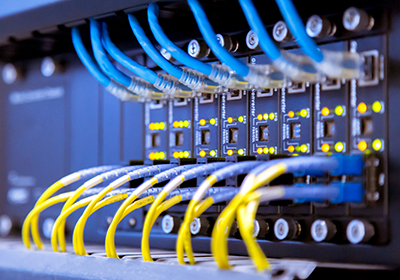What is network cabling – a complete guide
What is network cabling – a complete guide
Network cabling refers to the physical infrastructure that allows data to be transmitted between devices on a network. A properly installed network cabling system can provide reliable and high-speed connectivity, ensuring that data is transmitted quickly and accurately.
There are many types of network cables. Cat5, Cat6, and Cat7 are types of twisted-pair copper cables used in network cabling. Each type of cable has different characteristics and specifications that determine its performance and suitability for different applications.
Here are some key differences between Cat5, Cat6, and Cat7 cables:
Cat5: Cat5 is an older type of network cable that can transmit data at speeds up to 100 Mbps. It has four twisted pairs of copper wires and uses RJ45 connectors. Cat5 cable is still used in some applications, but it has largely been replaced by newer, faster cables.
Cat6: Cat6 is a newer type of cable that can transmit data at speeds up to 10 Gbps. It has four twisted pairs of copper wires, just like Cat5, but it is made with higher-quality materials and has more stringent manufacturing standards. Cat6 cable also has better resistance to crosstalk and interference than Cat5, which makes it suitable for high-bandwidth applications such as streaming video or online gaming.
Cat7: Cat7 is the newest type of twisted-pair copper cable, designed to support even higher speeds and bandwidth than Cat6. It has four individually shielded twisted pairs of copper wires, which provides better resistance to interference and crosstalk. Cat7 cable also has a higher maximum frequency (up to 600 MHz), which allows for faster data transfer rates. However, it is more expensive than Cat6 and may require special connectors or equipment.
In summary, Cat5, Cat6, and Cat7 cables are all types of twisted-pair copper cables used in network cabling. Each type of cable has different performance characteristics and is suitable for different applications depending on the required speed, bandwidth, and environmental conditions.
Here is a step-by-step guide to network cabling:
- Plan the network: Before installing network cabling, it is important to plan the network topology and determine the locations of switches, routers, and other network devices. This will help determine the type and amount of cabling required.
- Choose the appropriate cable type: There are several types of network cables, including twisted-pair copper cables (such as Cat5e, Cat6, and Cat7), fiber optic cables, and coaxial cables. The choice of cable will depend on factors such as distance, bandwidth requirements, and the environment.
- Measure and cut the cables: Measure the distance between the network devices and cut the cables to the appropriate length. Be sure to leave some slack to allow for future adjustments.
- Strip the cables: Use a cable stripper to remove the outer jacket from the cable, exposing the individual wires or fibers.
- Terminate the cables: Depending on the type of cable, it may be terminated with connectors such as RJ45 plugs for twisted-pair cables or SC or LC connectors for fiber optic cables. Follow the manufacturer’s instructions to ensure proper termination.
- Install the cable: Run the cable through conduits or cable trays, making sure to avoid sharp bends or kinks that could damage the cable. Use cable ties or clips to secure the cable to walls or other surfaces.
- Test the cable: After installation, use a cable tester to verify that the cable is properly terminated and free of defects or impedance issues. This can help identify any problems that could affect network performance.
- Label the cables: Labeling each cable can help identify and troubleshoot issues in the future. Use a labeling system that is easy to understand and consistent throughout the network.
- Maintain the network: Regularly inspect and maintain the network cabling to ensure that it is free of damage, corrosion, or other issues that could affect performance. This can help extend the life of the cabling system and prevent costly downtime.
In summary, network cabling is an essential part of any network infrastructure, providing a reliable and high-speed connection between devices. By following best practices for planning, installation, and maintenance, network cabling can help ensure that data is transmitted quickly and accurately.
